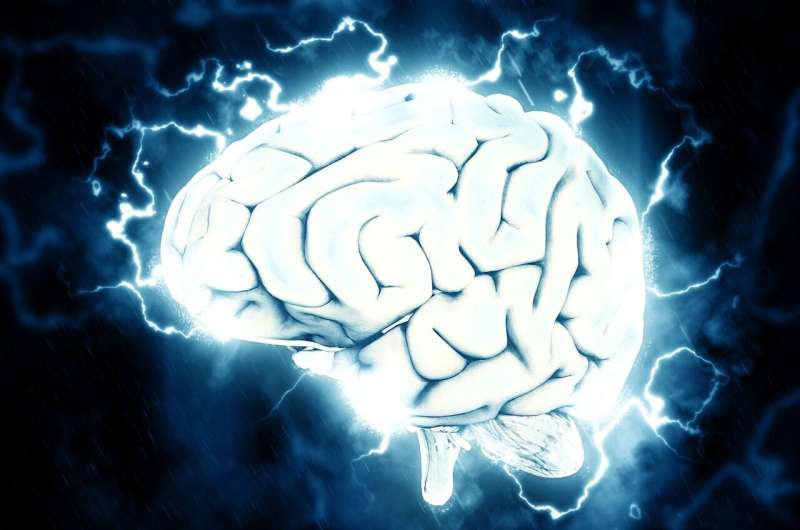This article has been reviewed according to Science X's editorial process and policies. Editors have highlighted the following attributes while ensuring the content's credibility:
fact-checked
peer-reviewed publication
trusted source
proofread
New studies of brain activity explain benefits of electroconvulsive therapy

Electroconvulsive therapy (ECT), formerly known as electroshock therapy, involves inducing a brief seizure in the brain using controlled doses of electricity. While ECT is highly effective for certain mental illnesses, particularly depression, the reasons for its efficacy have long puzzled the fields of psychiatry and neuroscience.
Now, researchers from University of California San Diego may have an answer. In two new studies published in Translational Psychiatry, they propose a new hypothesis that ECT alleviates depression symptoms by increasing aperiodic activity, a type of electrical activity in the brain that doesn't follow a consistent pattern and is generally considered to be the brain's background noise.
"We're solving a puzzle that's stumped scientists and doctors since electroconvulsive therapy was first developed nearly a century ago," said first author Sydney Smith, a Ph.D. candidate in the Voytek Lab at UC San Diego. "On top of that, we're also helping to demystify one of the most effective yet stigmatized treatments for severe depression."
Electroconvulsive therapy has a great track record, but a bad reputation. The therapy is effective in up to 80% of patients who receive the treatment, most often for depression but occasionally for bipolar disorder or schizophrenia. However, despite this high success rate, electroconvulsive therapy is frequently associated with frightening images of people receiving painful, high voltage shocks.
"A lot of people are surprised to learn that we still use electroconvulsive therapy, but the modern procedure uses highly controlled dosages of electricity and is done under anesthesia," said Smith. "It really doesn't look like what you see in movies or television."
While generally safe and effective, ECT does have drawbacks, including temporary confusion and cognitive impairment. It also requires multiple outpatient visits, which can present a barrier to some people who might otherwise benefit from the treatment.
"One of the reasons ECT isn't more popular is that for a lot of people, it's easier and more convenient to just take a pill," said senior author Bradley Voytek, Ph.D., professor of cognitive science at UC San Diego. "However, in people for whom medications don't work, electroconvulsive therapy can be life-saving. Understanding how it works will help us discover ways to increase the benefits while minimizing side effects."
The researchers used electroencephalography (EEG) scans to study the brain activity of patients who received ECT therapy for depression. They also looked at another similar form of treatment called magnetic seizure therapy, which induces a seizure with magnets instead of electrodes. Both therapies showed increased aperiodic activity levels in patients' brains post-treatment.
"Aperiodic activity is like the brain's background noise, and for years scientists treated it that way and didn't pay much attention to it," said Smith. "However, we're now seeing that this activity actually has an important role in the brain, and we think electroconvulsive therapy helps restore this function in people with depression."
One of the functions of aperiodic activity in the brain is helping control how neurons turn on and off. Our neurons are constantly going through cycles of excitation and inhibition that correspond with different mental states. Aperiodic activity helps boost inhibitory activity in the brain, effectively slowing it down.
"Something we see regularly in the EEG scans of people who receive electroconvulsive or magnetic seizure therapy is a slowing pattern in the brain's electrical activity," said Smith. "This pattern has gone unexplained for many years, but accounting for the inhibitory effects of aperiodic activity helps explain it. It also suggests that these two forms of therapy are causing similar effects in the brain."
While these findings establish a link between aperiodic activity and ECT benefits, the researchers stress the need for further investigation to leverage these insights in clinical applications. They are currently exploring the possibility of using aperiodic activity as a metric of treatment effectiveness in other depression treatments, such as medications.
"At the end of the day, what's most important to patients and to doctors is that the treatment works, which in the case of ECT, it does," said Voytek. "However, it's our job as scientists to dig into what's really going on in the brain during these treatments, and continuing to answer those questions will help us find ways to make these treatments even more effective while reducing negative effects."
More information: Translational Psychiatry (2023). doi.org/10.1038/s41398-023-02631-y
Translational Psychiatry (2023). doi.org/10.1038/s41398-023-02634-9




















